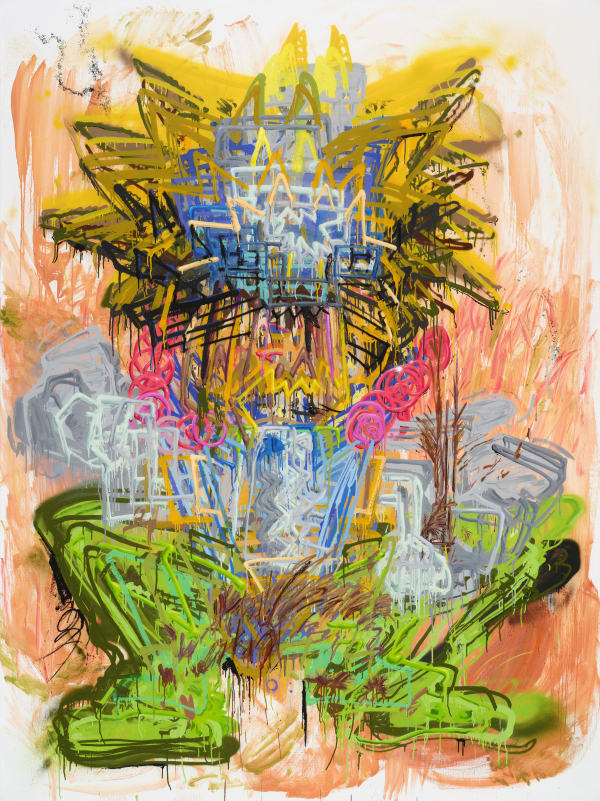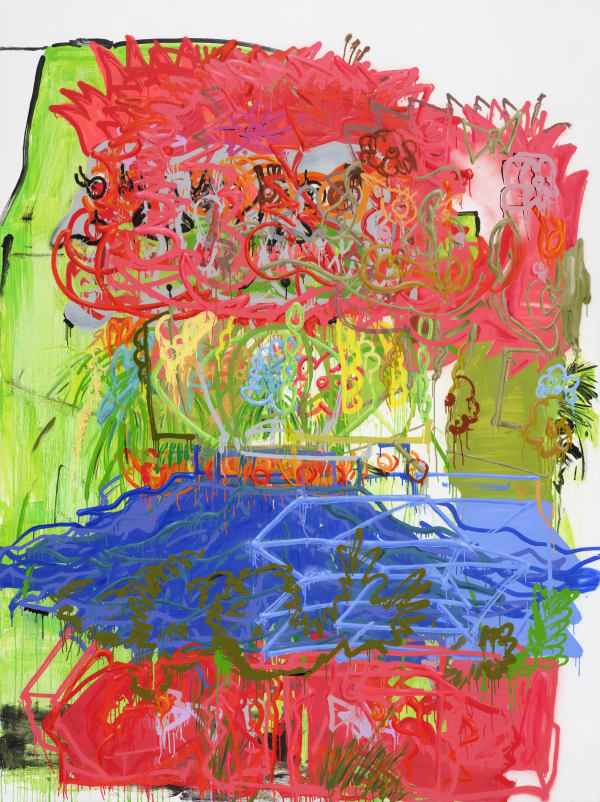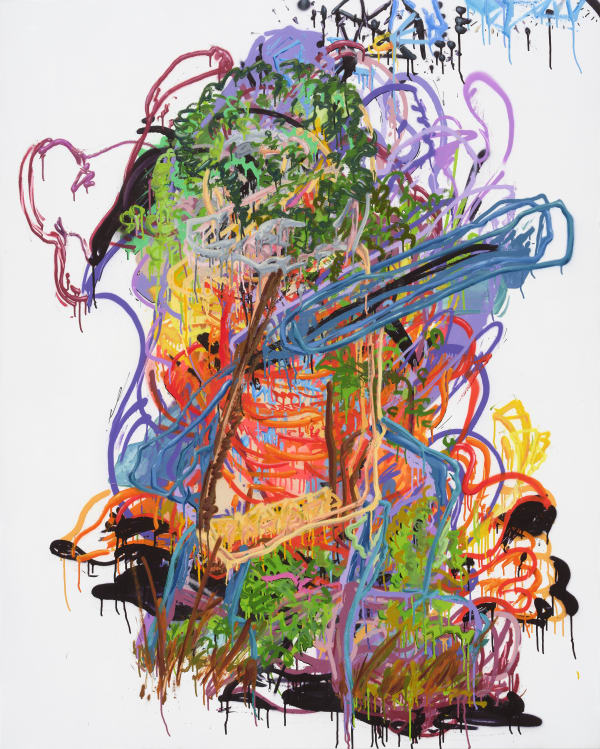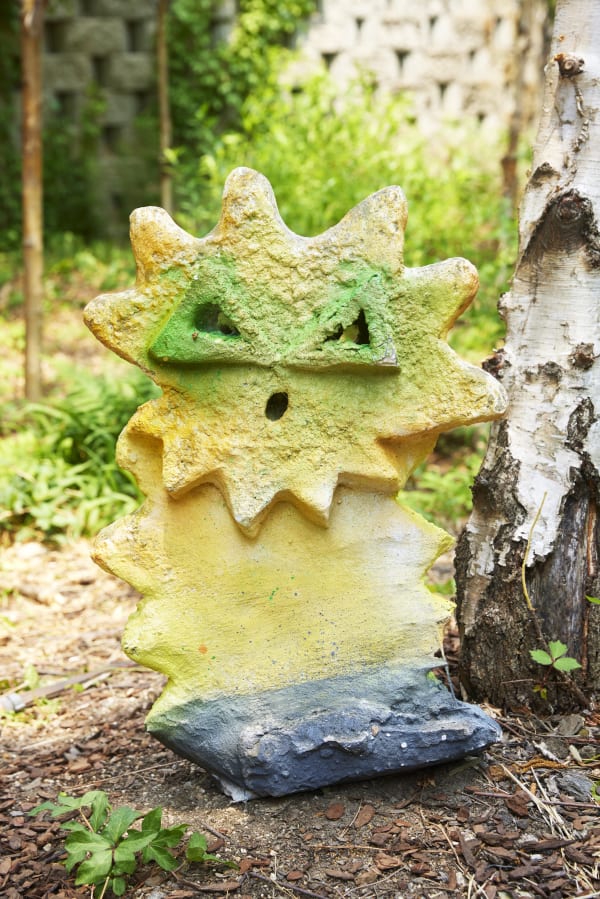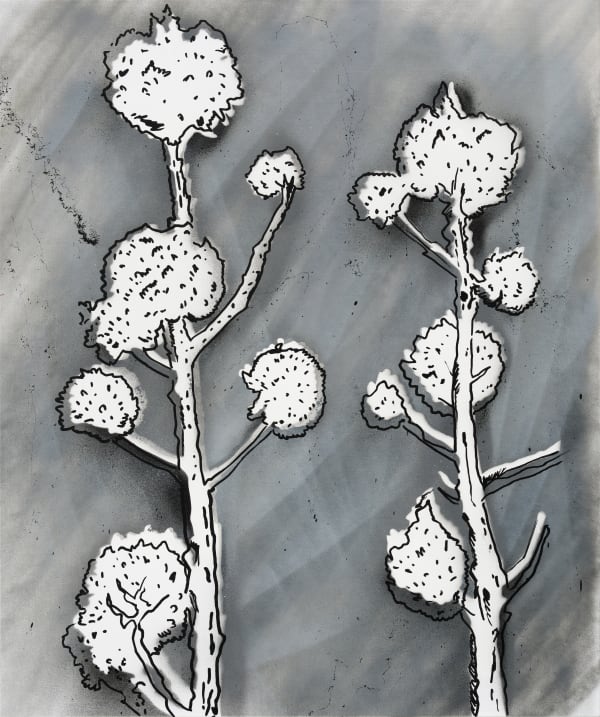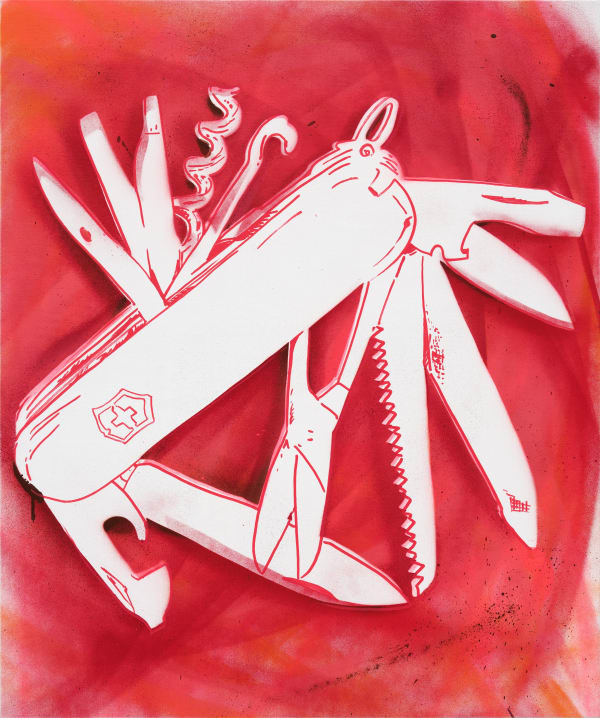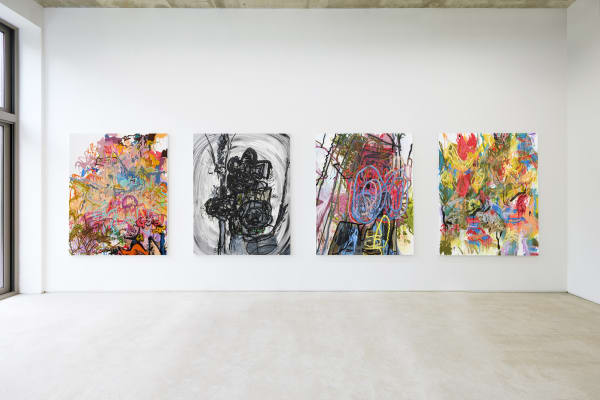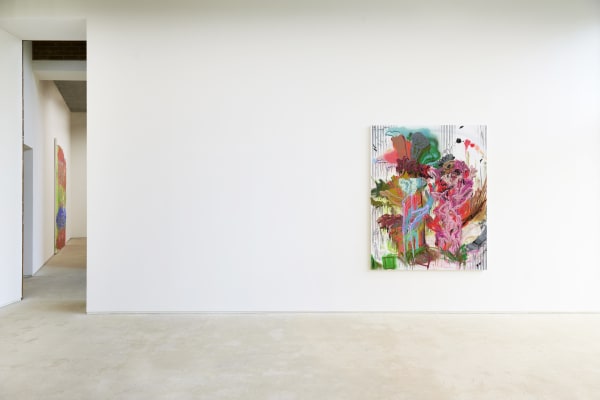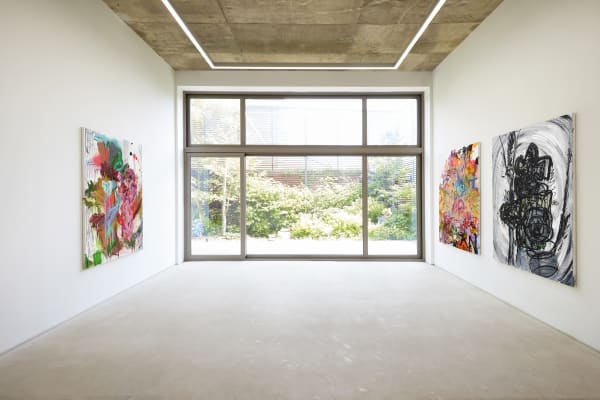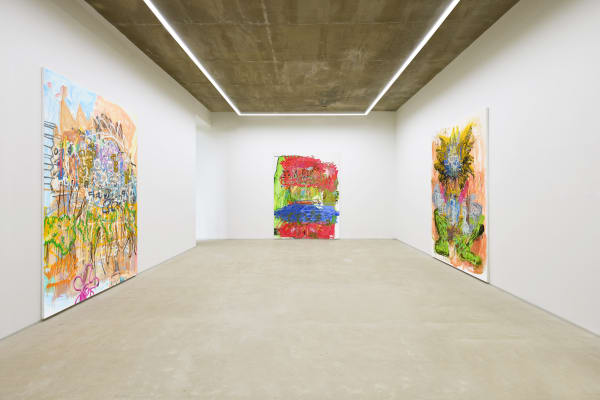도깨비 공원 DOKKEBI PARK: 이해강 Haekang Lee
도깨비공원은 이해강의 부친이 제주도에 조성한 공원이다. 이곳은 2005년 문을 열었지만 2년 뒤 아버지의 갑작스러운 죽음으로 공원 운영에 어려움을 겪게 된다. 5-6년 전부터는 아예 운영이 중단되어 지금은 부동산 매물로 내놓은 상태다. 공원은 처분해야 하는 짐이기도 했지만 막상 진짜 사라질 수도 있다고 생각하니 작가는 아쉬운 마음이 들었다고 한다. 그래서 이번 개인전은 도깨비공원에서 수집하고 기록한 결과물을 보여주려고 한다. 그는 객관적인 자료를 제시하기보다는 17년의 시간을 한 화면에 압축하거나 파편적으로 보여주는 방식을 선택했다.
이해강은 그동안 서로 다른 성질의 두 요소의 애매모호한 중간 지점이나 어느 곳에도 온전히 소속되지 못하는 이들을 탐구해 왔다. 나이를 중시하는 한국 사회에서 한 살 터울의 관계를 복잡하게 만드는 빠른 연생, 어디에도 환영받지 못하는 영화나 애니메이션 속 빌런, 타인에게는 하나로 보이지만 둘 사이의 갈등과 우열이 존재하는 대중문화 속 듀오 등이 그가 다룬 주제였다. 이것은 서브컬쳐와 현대미술을 오가며 활동하는 자신의 상황을 은유한다. 작가는 자신의 상황이나 입장을 호소하지 않고 마치 다른 이들을 대변하듯이 감정적으로 거리두기를 해 왔다. 하지만 이번에는 다르다. 전시는 그의 가장 개인적인 이야기를 담고 있다.
2005년, 작가의 부친은 8년에 걸친 계획 끝에 제주도 북제주군 조천읍에 도깨비공원을 열었다. 제주도 테마파크의 1세대라고 할 수 있는 도깨비공원은 개관 때부터 많은 화제를 모았다. 제주대 산업디자인과 교수였던 부친은 공원을 짓기 위해 6천여 평의 대지를 매입하고 제자들과 함께 1998년부터 본격적으로 사업을 시작하게 된다. 공원 개장 당시 동백나무 3,000여 그루를 비롯하여 총 7,000여 그루의 나무와 실내∙외 총 2,300여 점의 조형물을 조성했다. 조형물 제작 인원은 8명뿐이었고, 부친은 직접 포클레인 자격증을 취득할 정도로 열정적이었다. 이해강은 본인도 작가가 돼서야 비로소 도깨비 공원이 아버지의 일생일대의 프로젝트이었음을 짐작하게 됐다.
실제로 매도될 뻔한 상황을 몇 번 겪으면서 이해강은 공원을 빨리 팔고 싶은 마음과 함께 그대로 두고 싶은 양가적인 마음을 깨닫게 된다. 그는 물리적으로 공원이 사라지더라도 나름의 방식으로 공원을 기록하고 전시하기로 계획한다. 이러한 다짐으로 가장 먼저 한 일은 공원을 다시 가보는 것이다. 공원을 훤히 알고 있다고 생각한 그는 다시 공원을 돌아보면서 새로운 사실을 새록새록 알게 되어 놀랐다고 한다. 예를 들어 대형 도깨비 중 하나인 ‘깨뽀’가 3면의 얼굴을 가진 도깨비였다는 것을 17년 만에 발견했다. 너무 큰 조형물이다 보니 전체 형태를 오히려 몰랐던 것이다. 그에게는 너무 큰 충격인데 그 누구도 공감해주지 못한다. 심지어 가족들까지!
<D 5 - 깨숑>, < D 6 - 앵두깨비>, <D 9 - 깨뽀>, 등의 대형 회화는 도깨비 조형물을 샘플링한 작업이다. 이해강은 먼저 자료 조사를 통해 확인한 조형물의 초기 모습에서 색이 바랜 현재 모습으로 변화하는 과정을 애니메이션을 만들었다. 그리고 애니메이션의 여러 프레임을 스프레이 페인트를 사용해서 한 화면에 동시에 담아냈다. 시간의 변화를 압축한 이 그림에서는 이미 스프레이 페인트가 분사된 부분 위에 또 다른 프레임의 색과 선이 쌓이면서 앞서 그린 이미지들이 모두 덮이고 만다. 작가가 이렇게 수고스러운 과정을 반복하는 것은 얇게 분사된 페인트가 쌓이면서 만들어내는 지층 같은 단면을 구현하기 위해서다. 그는 스프레이 페인트가 만들어내는 이 마티에르를 무시할 수 없기에 성실하게 뿌리고 덮는 과정을 반복했다.
<P>시리즈는 종이를 레이저 컷팅해서 만든 형상을 캔버스 위에 놓고 스프레이로 배경을 칠한 뒤 마카로 형상의 윤곽을 그린 작품이다. 그림의 주인공들은 공원에 존재하는 조형물, 식물 그리고 작가의 마음속에 공원과 연결되는 대상들이다. (몇 젓가락 먹지도 못하고) 공원에 쏟아버린 새우탕면, 삼부자가 모두 맥가이버 머리를 했던 기억 때문에 아버지를 떠올리게 하는 맥가이버 칼(스위스 군용 칼), 공원을 돌아다니며 들었던 아이리버 MP3, 공원에 자라는 풀 등. 작가는 그림의 형식을 고민하지 않고 사물을 통해 자신의 이야기를 하나씩 꺼내 보는 것 같아 즐거웠다고 한다. 외부에 설치된 도깨비 조형물은 실제로 도깨비 공원에서 가져왔다. 파손된 부분은 백시멘트로 메우고 스프레이 페인트로 색을 덧입혔다. 그는 시간에 의해 훼손된 도깨비의 형태와 색을 복원한 것이다.
이번 전시는 스프레이 페인트와 유화를 함께 사용하던 이전과 달리 스프레이 페인트를 주로 사용해서 캔버스 화면에 페인트가 번지는 모습이나 스프레이만의 마티에르 등 재료의 물성을 탐구했다. 매체에 대한 연구와 함께 이번 전시를 통해 보여주는 큰 변화는 바로 자신의 개인적인 이야기를 작품에 담았다는 것이다. 그는 전시를 준비하면서 아버지를 많이 생각했다고 한다. 그렇다고 전시가 감동적이길 바라는 것은 아니다. 도깨비공원을 기록한 이유는 단지 ‘아버지의 공원’이여서가 아니라 한 사람이 완성한 ‘일생일대의 프로젝트’에 대한 존경과 회고를 담기 위함일 것이다. 작가 역시 한 명의 창작자로 자신만의 방식으로 (사라져 버릴) 도깨비공원을 의연하게 기록했다. 가족들 역시 담담하다고 한다.
Dokkebi Park is on Jeju Island, imagined and created by artist Lee Haekang's father. The park opened in 2005, only two years before the artist’s father passed away under unexpected circumstances. The park's future became uncertain. This liminal state of the park continued until about 5-6 years ago, when the park had to close its gates completely. It is presently listed on the real estate market. Lee Haekang knew that the park had to be let go as it was a burden in many ways, but the possibility of the park being no more was a reality he struggled to come to terms. As a final homage to his father's work, Lee documented Dokkebi Park in Jeju Island to present a solo exhibition of his documentation. His presentation is hardly objective or even singularly tangible; he chose to present 17 years through compression and fragmentation.
Lee's works have explored the vague and ambiguous middle ground between dissimilar elements, as well as people and beings that do not belong in one or the other, but the third. Artist’s observations and explorations of liminality have included the strictly Korean cultural concept of being born early in the year (where the Lunar calendar and the Solar calendar places a person in two separate years, confuscating typical age hierarchy), villains in films and serialized shows who could have been fantastic anti-heroes or even heroes - had it not been for the dichotomous plot device. This duality of the sides of the same coin in popular culture where one side is arbitrarily better than the other has been a topic of exploration and interest for Lee. With roots in graffiti and street sub-culture but active in the contemporary art scene, Lee Haekang is also the embodiment of this in-betweenness. His works are in many ways stories of his own, told through different metaphors. He doesn't like to wear anything on his sleeves. He rarely shares anything about what situation he is in, or what his intentions lie. His works speak for him - or should I say he seems to paint as if he were a spokesperson for someone else? Whichever it may be, Lee has maintained a detached demeanor to his practice. Until now. This is his most personal story.
In 2005, after 8 years of planning, the Lee's father opened Dokkebi Park in the township of Jocheon-eup, North Jeju County, Jeju Island. As a bona fide first-generation theme-park establishment on Jeju Island, the opening of Deokkebi Park caught the attention, interest, and excitement of many. Lee Senior was a professor of industrial design at Jeju National University who had a vision for the park. He bought a plot of land over 6,000 pyeong (20,000 sqm) for the park and with a team of students, began working earnestly on Dokkebi Park. When the park was unveiled, the plot had more than 7,000 trees planted around the park, with more than 3,000 camellia trees carefully planted among them. Altogether in indoor and outdoor spaces, the park featured more than 2,300 sculptural objects. Only 8 individuals had been at work to create the sculptures, and Lee Senior himself acquired heavy machinery - excavator - operator certification in order to be maximally engaged. It was only after Lee Junior became an artist himself that he came to understand his father's dream of Dokkebi Park as his life's project.
The closed park was nearly sold several times, and through those close-calls Lee found that he had ambivalent feelings about the park. When offers came in, he felt relieved to sell yet also regretful and hoping to leave everything as-is. From that experience, Lee Haekang decided to record, document and present Dokkebi Park through the medium of his art, to have something when the physical park itself is no longer. The first order of this decision was to return to the park. Lee was confident returning to Dokkebi Park. He had been there many times before, and it would be like the back of his hand. This was not so. There were many discoveries to be made upon his return and tour of the now closed park. For example, Kkeppo, one of the larger Dokkebis (dokkebi are nature deities or spirits possessing extraordinary powers and abilities that are used to interact with humans and are distinct from other troll-like characters in East Asian mythologies, as they tend to lean toward chaotic-neutral in their disposition) had a face with three sides. Lee did not recall this from 17 years ago, something he had overlooked as Kkeppo was quite large and he had not perceived the whole figure to understand its anatomy. The discovery was shocking, but also frustrating as none would sympathize with him - not even his own family!
D 5 - Kkesyong, D 6 - Aengdukkebi, D 9 – Kkeppo at Lee's solo exhibition are large-scale paintings based on samples of the large Dokkebi sculptures he documented during his visit. The first thing that Lee Haekang did with the documented material from the park was to create an animation that depicted the sculptures gradually fade in color and distinctness over time, eventually reaching the state he witnessed and documented during his visit. Numerous frames in the animation were sprayed with aerosol paint to simultaneously express on a single panel. A compressed and abridged record of time, the paintings stack frames, colors, and lines over what the canister of paint has sprayed, eventually obfuscating all that he had painted earlier. This carefully executed trouble and effort is iterated in order to materialize a thin strata - and its accumulated cross-section of it. The matière of aerosol paints are compelling, and that was reason enough to iterate the spraying and painting-over numerous times.
The <P> series are felt-tip markers tracing laser-cut paper forms over spray painted canvas. The protagonists of the series all have something to do, something connected and reminiscent (for the artist) of Dokkebi Park's structures and plants. The prawn-noodle instant cup noodle that he spilled at the park before hardly getting a mouthful. The Swiss Army multitool pocketknife that brought back memories of the MacGyver-esque mullet hairstyle of father and two sons, the iRiver MP3 music player that Lee used to listen to as he strolled Dokkebi Park, the green grass that grew around the park, and so on. These were all totems that took him to a time and place in a way that felt free of artistic form and painting style. Objects were directly relevant to his personal recollections that he drew out. It brought joy. The large dokkebi figure installed outside are in fact brought from Dokkebi Park. Damaged parts were puttied and spray-painted over. What form time had damaged, he returned in form and color.
Unlike previous styles of combining aerosol paints and oil paints, Lee makes extensive use of aerosol spray paints to express the spreading of paint on canvas, and various other unique aspects of spray paint matière. Both a study in media and new directions, Lee's solo exhibition stands out as a personal memoire. He shares that working on this exhibition often brought him back to memories of his father. Lee somehow remains detached in saying that he isn't expecting this exhibition to pull any heart strings. The reason for documenting Dokkebi Park is not simply because it was his father's, but rather to capture and honor a person's project of a lifetime. As a creative himself, Lee Haekang documented Dokkebi Park (to be eventually lost) with dignity, gravitas, and by means he knows best as an artist. His family members too were also calm and composed regarding this exhibition.
